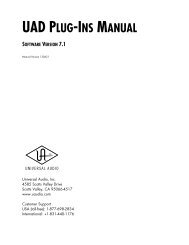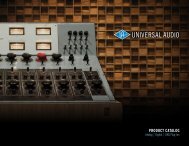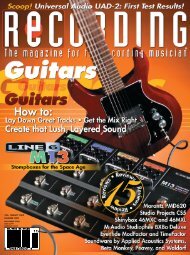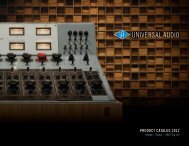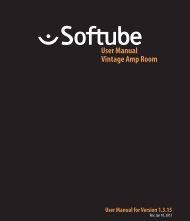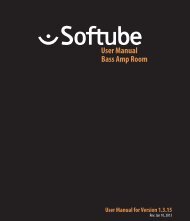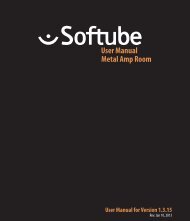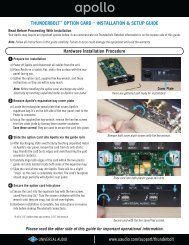bx_digital V2 Manual.pdf
bx_digital V2 Manual.pdf
bx_digital V2 Manual.pdf
You also want an ePaper? Increase the reach of your titles
YUMPU automatically turns print PDFs into web optimized ePapers that Google loves.
x_<strong>digital</strong> <strong>V2</strong> manual<br />
Start EQ-ing the M- and S-section individually while Solo-ing the respective<br />
section - and don´t forget to switch the Solo-buttons off from time to time<br />
and listen to your complete mix in “full stereo sound” again. This way you get<br />
a feel for how your adjustments on the individual sections effect the whole<br />
stereo mix! After you have used a few EQ-bands on your mix compare it to your<br />
original mix by using the Bypass switch of the whole unit and/or of individual EQ<br />
bands (a new feature in <strong>V2</strong>).<br />
Mastering in M/S takes a little time to get used to - it´s just really different<br />
EQ-ing 2 separate mono-sums than EQ-ing conventional L&R-signals. But,<br />
it´s a very musical way of working, and there IS a reason why some of the<br />
top mastering studios in the world have been working like this for ages with<br />
custom-made M/S-boards - without really telling anybody…<br />
drums, snares, lead vocals, bass, etc.) in your mix disappear completely.<br />
If that´s the case you can be sure that your mix IS balanced!<br />
Make your mix wider than it originally was by increasing the Stereo Width<br />
without losing the center of your recordings! You will not loose bass drum<br />
power or vocals by making your mix wider this way… and it will not sound<br />
different played back in mono at all.<br />
Otherwise, if you have a drum-loop that was recorded with too much ambience<br />
sounds / reverb, just get rid of it by decreasing the Stereo Width (in all modes!).<br />
M/S-Mastering might just be the key for your music to sound as big - yet still<br />
open and clear - as productions often referred to as being „BIG“… :-)<br />
Many people who have used the M/S-modes for the first time told us that<br />
they had the impression of a “3D-like” depth in their mixes after processing the<br />
M- and the S-Signals individually. While using the M/S-technique for mastering<br />
does affect your phases in the stereo-signal we do not see this as a problem.<br />
In M/S modes altering phases is done intentionally. Of course, though, the<br />
M/S mastering mode works best if you want to correct small mistakes in your<br />
mixes… for adding or cutting away big amount of general bass or treble signals<br />
you might be better off working in L/R-mode…<br />
tt<br />
TIP: if needed simply use two instances of <strong>bx</strong>_<strong>digital</strong> on your master bus.<br />
one in L/R mode, the second in M/S mode.<br />
Once you are used to the basics of M/S you might easily get into more detailed<br />
functions… try balancing out a mix that is not centered 100% (most mixes<br />
that come from an analogue desk with inserted compressors, EQs, in the<br />
main stereo insert, etc. are not balanced 100%!) by Solo-ing the S-section and<br />
adjusting the Balance Gain until all the things that should be centered (like bass<br />
6



